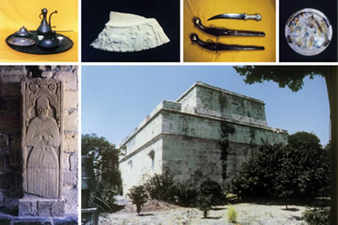Cyprus in brief
Cyprus is the third largest island in the Mediterranean, characterized by superb climate and constant sunshine throughout the year. It is considered as a modern European country with appreciable ancient enchantment. The island’s secure (crime free) environment along with the spectacular scenery of turquoise seas, or pine clad mountains, the long history and rich culture provide a perfect formula for an experience everyone will remember. Cyprus may be reached by air in no time from continental Europe, the Middle East and Africa, and well served by all major airlines.
Apart from its key location amongst three continents, Cyprus is characterized by its fully mature hospitality industry, coupled with sophisticated communication facilities, extensive highway system and airline network connections.
Main cities:
- Lefkosia (Nicosia), the island’s capital, combines both old and new in a busy modern commercial and business centre and a centuries-old culture. The centre of the city has its old quarter surrounded by a Venetian sandstone fortress wall with a moat and heart-shaped bastions. Nicosia, is the Island’s centre of most of the government departments and various embassies.
- Lemesos (Limassol) is the island’s second largest city, the island’s main port, the centre of the wine industry and a bustling holiday resort. It is renowned for its varied nightlife
- Larnaka may be considered as the international gateway to Cyprus, having the island’s second port and the main international airport
- Pafos, to the west of the island, is an archaeological treasure trove, with some of the finest mosaics in the Mediterranean

About Lemesos
The island’s second largest city, Lemesos (Limassol) is the island’s main port, the centre of the wine industry and a bustling holiday resort. The city fans out between two of the most spectacular archaeological sites in Cyprus built on cliff tops with spectacular views overlooking the sea – the ancient city-kingdom of Amathus to the east and Kurion to the west. Finds from these sites have made their way abroad, such as an enormous stone vase, one of the largest ever found, unearthed at Amathus is now at the Louvre Museum in Paris, while objects from Kurion are displayed in the Metropolitan Museum of Art in New York.
The sun-kissed southern slopes of the Troodos mountains with their vineyards form a pleasant green backdrop to the city, dotted with delightful hillside villages known collectively as the ‚Krassochoria‘ (or wine villages). The old forms of viticulture are still kept alive here producing the island’s best dry red wines. The most famous of all the wines is Commandaria, one of the oldest named wines in the world, having had the same name for eight c enturies. It was originally produced and exported by the Hospitallers, the Knights of St. John of Jerusalem, from Kolossi castle, where they had their headquarters (Grand Commandery), and which can still be seen today on the outskirts of the city.
enturies. It was originally produced and exported by the Hospitallers, the Knights of St. John of Jerusalem, from Kolossi castle, where they had their headquarters (Grand Commandery), and which can still be seen today on the outskirts of the city.
Germasogeia dam and Akrotiri salt lake are unique wetlands ideal for observing nature and wildlife and peaceful places to relax, go for a walk or indulge in some angling. Birdwatching enthusiasts may see herons, ducks, chaffinches, cormorants and kestrels, or even the Greater Flamingo which winters at Akrotiri in the thousands.
General Information
- Greek is the mother tongue (official language), while English is widely spoken.
- Coastline: 648 km
- Population: 754,064 (July 1999 est.)
- Capital: Nicosia
- Cyprus is a full member of the European Community and the currency of the Republic of Cyprus is €.
- Airports: Cyprus has two airports: Larnaca International Airport (LCA) and Paphos International Airport (PFO). Around 30 airlines connect Cyprus directly with most European and Middle-East countries, which provide ongoing services to anywhere in the world.
- The voltage is 240 Socket outlets are of flat 3 pin-type.
- Telephone code: (+357)
Cyprus History
- Experience at first hand one of the oldest civilisations of the Mediterranean, one that goes back 10,000 years. Cyprus’ history has brought up innumerable finds over the years, so much so that it is said if you scratch the soil anywhere on the island you are bound to unearth a relic from the past.
- Conquered by foreign powers throughout its long history, the island is like a large open air museum where you can see evidence of its chequered past. Ancient Greeks, Romans, Egyptians, Phoenicians, Venetians, Ottomans and British all left their mark, making the island a mosaic of different cultures and periods.
- Famous for its copper in antiquity, Cyprus (‘Kypros’ in Greek) may even have given the metal its Latin name, cuprum. The cult of Aphrodite, the ancient Greek mythological goddess of love and beauty, flourished here and people came from miles around to take part in celebrations in her name.
- The island was the first country the apostles Paul and Barnabas visited in their mission to spread Christianity and the first to come under Christian administration.
- When Cyprus became part of the Byzantine Empire art and architecture flourished here; the 12th century is considered to be the Golden Age of Byzantine painting in Cyprus. As a distant outpost of Byzantium, Cyprus escaped the iconoclastic decrees of the 8th century and much of its Byzantine art has survived here.
